2019 McLaren Senna
At the 2018 Geneva Motor Show, McLaren unveiled the concept version of the track-only iteration of the Senna dubbed the Senna GTR. The production Senna GTR unveiled two years later has a different bodywork from the concept, with a different wing setup, toned-down aerodynamics, and utilizes a dual-clutch race transmission for faster gear shifts, a revised suspension system and Pirelli racing slicks in order to make it the fastest non-Formula One vehicle McLaren has ever created for faster lap times. The Senna GTR is estimated to produce at least 825 PS (607 kW; 814 hp) from its 4.0 L twin-turbocharged V8 engine and is meant to be faster and more agile than its road-going counterpart. On the exterior, the GTR utilizes wider front and rear fenders, a larger front splitter, new wheels and a bigger rear diffuser in order to make the car generate about 1,000 kg (2,204 lb) of downforce. The Senna GTR will be limited to only 75 examples.
PRICE ON REQUEST
(All information was given to the best of our knowledge and belief; errors excepted and subject to change.)
Sales | Scouting | Expert advice
Mobil: +49 172 14 800 81
2019 McLaren Senna GTR
On this page you can find 12 high resolution pictures of the «2019 McLaren Senna GTR» for an overall amount of 44.61 MB.
Just click on any thumbnail to get the access to the full-size shot. All the images belong to their respective owners and are free for personal use only.
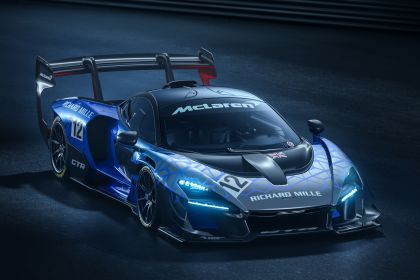
6000 x 4000 2.20 MB

6000 x 4000 1.29 MB

6000 x 4000 1.35 MB
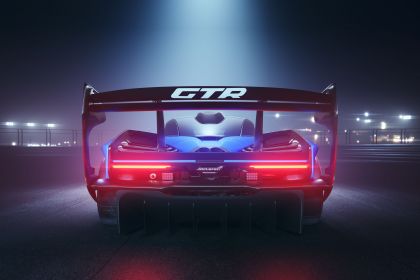
6000 x 4000 1.46 MB

6000 x 4000 1.97 MB
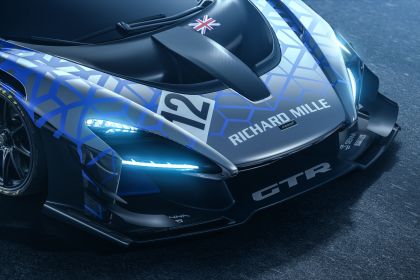
6000 x 4000 2.14 MB
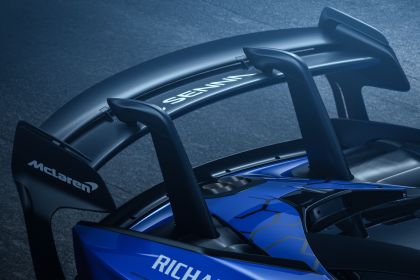
6000 x 4000 1.42 MB
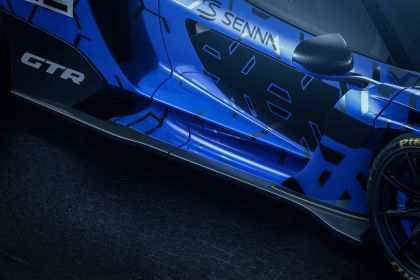
6000 x 4000 2.21 MB
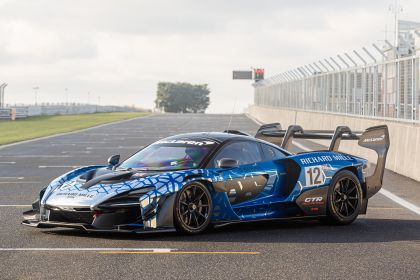
5269 x 3513 10.59 MB
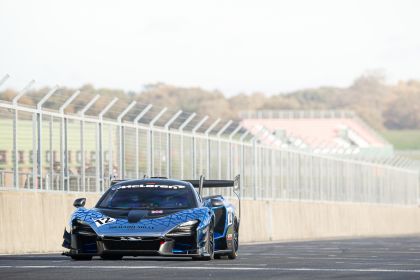
4920 x 3280 6.02 MB
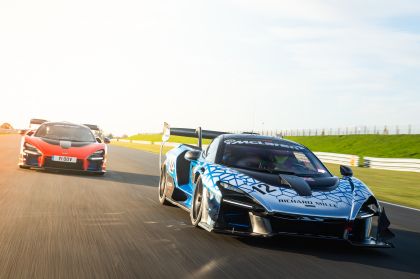
4997 x 3331 7.17 MB
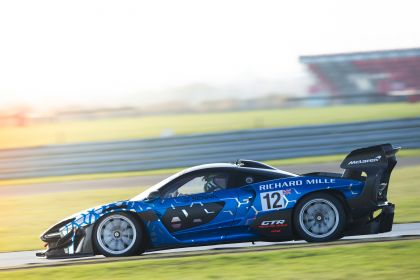
5184 x 3456 6.79 MB
- McLaren Automotive’s most extreme track car yet revealed in final form
- Evolution of 2018 McLaren Senna GTR Concept takes acknowledged McLaren Senna dynamism into new realms of performance as the quickest track McLaren outside of Formula 1
- Faster, lighter, more powerful and race-bred with focus on accessibility for drivers of all abilities
- 825PS from 4.0-litre, twin-turbocharged McLaren V8; lightest dry weight of 1,188kg gives power-to-weight ratio of 694PS-per tonne
- Same levels of downforce as the McLaren Senna, but at 15% lower speeds; peak downforce exceeds 1,000kg
- Newest and most exclusive member of McLaren’s Ultimate Series; 75 cars only, all sold
Just twelve months after it was revealed as a concept car at the Geneva International Motor Show, the McLaren Senna GTR is revealed as a fully-fledged track machine – uncompromised, unconstrained and unshackled by road or racing regulations.
McLaren Automotive’s most track-focused Ultimate Series car has evolved in key areas to deliver on its promise of hypercar power and accessible handling with the aerodynamics and chassis of a thoroughbred racer. The result is a machine able to lap circuits faster than any McLaren outside Formula 1, providing its owners, of all abilities, with an unparalleled track driving experience.
The McLaren Senna GTR takes the road-legal McLaren Senna – already the lightest, most powerful and track-focused but road-legal car that McLaren builds – several steps further into the realm of ultimate performance. Without the constraints of road or racing regulations, the new Ultimate Series car is more powerful, weighs less, boasts an incredible 1,000kg plus of aerodynamic downforce and uses suspension derived from McLaren’s GT3 race programme.
“The McLaren Senna GTR is a perfect example of our determination to bring our customers the Ultimate expression of track driving performance and excitement. The McLaren Senna was designed from the outset to be an extreme track car, but the 2018 McLaren Senna GTR Concept suggested how much more further we could go and now, free from the constraints of road car legislation and motorsport competition rules, we have pushed the limits of what is technically possible to advance circuit driving capability to another level entirely.”
Mike Flewitt, Chief Executive Officer, McLaren Automotive
The McLaren Senna GTR, which joins the McLaren Senna and McLaren Speedtail in the brand’s Ultimate Series, succeeds legendary predecessors the Le Mans-winning McLaren F1 GTR of 1995 and the McLaren P1™ GTR of 2015 and keeps the name that honours the memory of three-times McLaren Formula 1 World Champion, Ayrton Senna.
Each new McLaren Senna GTR offers its owner virtually unlimited opportunities for personalisation by McLaren Special Operations Options, from paint colours in the MSO Defined portfolio to unique, multi-hued liveries as an MSO Bespoke commission that imagines a wholly individual expression of track car artistry.
Just 75 McLaren Senna GTRs will be built to customer order at the McLaren Production Centre in Woking, UK, with first deliveries commencing September 2019. Priced from £1.1 million plus taxes, all cars were allocated to owners within weeks of the order book opening following the McLaren Senna GTR Concept debuting at the 2018 Geneva International Motor Show.
McLaren Senna GTR in detail
Powertrain
The McLaren Senna GTR is powered by the most extreme version yet of McLaren’s 4.0-litre twin turbocharged V8 engine. The M840TR unit, with electronically controlled twin-scroll turbochargers, produces 825PS (814bhp) with 800Nm (590lb ft) of torque. The extra 25PS over the engine in the McLaren Senna has been achieved by engine control recalibration and removing the secondary catalyst to reduce back pressure. Removing the catalyst also heightens the aural experience of driving the McLaren Senna GTR.
The exhaust system of the concept, which exited through side pipes just ahead of the rear wheels, has been replaced with a more conventional rear exit system on the production car, with the pipes now emerging from the rear deck under the rear wing in the same location as the Senna. The change was made for the purest of engineering reasons: the side exit pipes may have looked the part, but the rear exit pipes provided the shortest, quickest route for exhaust gases to exit, saving weight and reducing complexity.
With 825PS and a lightest dry weight of 1,188kg, the 694PS-per tonne power-to-weight ratio of the McLaren Senna GTR comfortably exceeds not only that of ‘regular’ McLaren Senna, but every other McLaren Automotive car for road or track currently in production.
Three powertrain modes are available to the McLaren Senna GTR driver: Wet, Track and Race. The new Wet setting, which provides greater support from the ESP and ABS electronic systems, is particularly intended for use with wet tyres. The transmission, which includes a Launch Control function, is the same, acclaimed 7-speed plus reverse Seamless Shift Gearbox (SSG) that features in the road-legal McLaren Senna.
Aerodynamics
Optimising aerodynamic efficiency and giving even more extreme track focus than that possessed by the McLaren Senna – a car already designed to excel on the track – called for a holistic approach that subjected all aerodynamic aspects to intense scrutiny. The McLaren Senna GTR Concept showed the direction and the production-ready car now stands ready to deliver the most effective aero performance for track driving of any McLaren Automotive product.
The McLaren Senna GTR generates astonishing levels of downforce, peaking at more than 1,000kg, a significant increase over the 800kg developed by the road-legal McLaren Senna at 250km/h (155mph). Crucially, a completely different downforce ‘curve’ means the McLaren Senna GTR can call on an equivalent amount of downforce to the McLaren Senna at 15% lower vehicle speed, while still benefitting from reduced drag. The aero package of the McLaren Senna GTR delivers positive effects in high-speed corners but also in low-speed curves and under braking, making the car even less pitch- sensitive and enhancing stability in all situations.
The front splitter has been reprofiled and the rear diffuser reduced in size compared to the components on the 2018 GTR Concept, to optimise performance and meet the required track performance standards. Other changes in comparison to the Concept include new dive planes on the front corners and vortex generators either side of the car to ensure a stable airflow underneath; overall, the aero elements of the McLaren Senna GTR work together to deliver balanced downforce front-to-rear over the entire speed range.
The new front splitter features a raised centre section to feed air under the car back to the newly reprofiled diffuser. The efficiency of the diffuser has, in turn, been optimised by the new rear wing – a design featuring LMP1-style endplates that connect wing to body in dramatic fashion and are a highly effective way to guide air around the back of the car.
Compared to the standard McLaren Senna wing fitted to the 2018 GTR Concept, the wing of the McLaren Senna GTR has been reprofiled and relocated, having been pushed backwards so its trailing edge is now outside the car’s footprint. This new, ‘free of road car restrictions’ position allows the wing to be coupled to the diffuser, making best use of the air flowing over the rear of the car.
Like the road-legal McLaren Senna, the McLaren Senna GTR features active aerodynamics in the shape of the active aero blades flanking the Low Temperature Radiator and an articulated rear wing – elements that are not currently permitted in GT3 racing but bring significant aero advantages. The wing can be ‘stalled’ for maximum speed thanks to an automatic drag reduction system (DRS).
Body and structure
The McLaren Senna GTR takes McLaren’s mastery of carbon-fibre to a new level of accomplishment for a McLaren track car, combining light weight with immense structural rigidity. One of the lightest cars that McLaren Automotive has ever produced, the McLaren Senna GTR tips the scales in lightest dry guise at 1,188kg.
At the core of the McLaren Senna GTR is a McLaren Monocage III-R central structure, a carbon-fibre safety cell with integrated roll cage and uniquely, integrated harness mounting points. Like the road-going McLaren Senna, there is an aluminium front subframe and aluminium engine frame, with composite crash beams front and rear. The extreme, racing-inspired nature of the carbon-composite body appears more purposeful than ever, clothing a chassis that is wider still than that of the Senna and lower than the road-legal Senna by 34mm, at 1,195mm in height. Front track has increased – by 77 mm to 1,731mm – and rear track is wider by 68 mm, at 1,686 mm.
The wider fenders, accommodating 19-inch centre-lock wheels, exaggerate the relative narrowness of the cabin and ‘ground’ the car even more securely. Additional aero devices have been added to the door skins to optimise airflow from the revised fenders.
The McLaren Senna GTR is 10kg lighter than even the McLaren Senna, already a paragon of race-bred leanness. And this is despite the track car’s wider track, extended body and the fitment of essential track equipment including pneumatic air jacks, pit radio, fire extinguishing system and data logger. Many of the creature comforts fitted to the McLaren Senna have been deleted for the McLaren Senna GTR, including touch screens and the audio system. To optimise comfort across the whole range of track conditions, air-conditioning has been retained.
The windscreen and side windows, with sliding ticket opening, are polycarbonate. The soft-close dihedral doors are fitted with a manual release mechanism, and the fuel filler has become a race-style dump-churn type. Exterior visual carbon-fibre aero elements have a gloss finish as standard. Wheel finish can be Gloss Black, Race Silver or Matt Dark Graphite and the colour of the door struts and brake calipers can be specified in Azura blue, red or McLaren Orange at no additional cost.
Chassis and running gear
The fastest, lightest, most aggressive and engaging McLaren yet has been carefully honed for accessibility, so the incredible track driving experience it offers is not exclusive to professional racing drivers. The target that the programme engineers set themselves was simple: to ensure that 95 per cent of the performance of the car could be accessed by 95 per cent of drivers. This is achieved in the McLaren Senna GTR by combining the balanced aerodynamic downforce of the road-legal car with new suspension derived from McLaren’s GT3 race programme.
The McLaren Senna’s variable ride control suspension, which enables different ride heights for road and track, is superfluous in the track-only car and to save weight and reduce complexity has been replaced with aluminium double wishbones, springs, uprights and anti-roll bars developed from the suspension of the GT3 cars used for McLaren’s customer racing programme. Four-way adjustable dampers are fitted, as are solid bushes and adjustable camber.
By not having to comply with GT3 regulations, which restrict the race cars to 18-inch wheels, the Senna GTR gets 19-inch rims like the road-legal Senna, but of a centre-lock design. The Ultra-Lightweight forged alloy wheels are also wider than current GT3 regulations allow, being 10J at the front and 13J at the rear. The 19-inch tyres are Pirelli slicks, sized 285/650 front and 325/705 rear.
The larger wheels mean even larger brakes than those fitted to a McLaren 720S GT3 car, for a system that delivers hugely impressive stopping power. Based on the braking system of the McLaren Senna, the Senna GTR is equipped with forged aluminium monobloc six-piston calipers at the front and four-piston at the rear, working on 390mm layered carbon-ceramic discs that feature machined cooling vanes. Like the road-legal McLaren Senna, the Senna GTR also has an air brake function on the rear wing, which in this guise has been designed to deliver 20 per cent greater maximum deceleration on its slick tyres than its road/track counterpart.
The McLaren Senna GTR is equipped with many of the electronic driver aids that provide safety on the road, including anti-lock braking, traction control and dynamic electronic stability control. Additionally, it features pit lane speed control; systems that monitor both tyre pressure and tyre temperature; brake pad wear sensors; brake disc-wipe technology and anti-collision radar.
Inside the McLaren Senna GTR
The McLaren Senna GTR is left-hand drive only, recognising the fact that hand of drive is less relevant in a track car as well as the fact that most buyers are located in LHD markets, An FIA-approved, lightweight carbon-fibre racing seat and six-point FIA harness is fitted, with a passenger seat available as a no-cost option. As befits a track-only car, the pared-back cabin does without airbags, infotainment and other driver aids. There is a satin finish to the carbon-fibre elements of the interior, the sills are covered in black carpet – the only carpet in the car, in fact – and the headlining is Alcantara®.
The folding instrument cluster and steering wheel from the road car have been replaced by race-spec items. The driver screen displays key data in the simplest forms, with a row of gearshift LEDs along the top edge. LEDs up the side of the pod count down the closing distance of cars behind via the standard anti-collision radar system, as used by top-tier endurance race cars. An additional centre display, replacing the road-Senna’s touch-screen, shows the view from the rear-mounted camera.
The race-spec steering wheel is based on the GT3 car’s wheel but with different functionality for the buttons, in line with the cabin’s one-button/one function ethos. The wheel, which is adjustable for both reach and rake, is quick release and features integrated gearchange paddles.
The Senna GTR is equipped with a pit-to-car radio and two on-board cameras: one forward facing and one in the cabin. There are simple on-off buttons for launch control, pit lane speed control and light rain dynamic setting. As with the road-legal McLaren Senna, the engine start button is mounted in the roof. And when that big red button is pressed, the McLaren Senna GTR snarls into life, ready to deliver Ultimate thrills on the track of your choice. A fortunate 75 buyers will already be starting to think seriously about just where they will be heading.
Mclaren p1 gtr senna 2019 zip

| gt | Ultimatecarpage.com > Cars by brand > Great Britain > McLaren Racing cars > GT Cars Senna GTR |
| McLaren Senna GTR |
| Country of origin: | Great Britain |
| Produced in: | 2019 |
| Numbers built: | 75 (Limited Production) |
| Introduced at: | 2018 Geneva Motor Show |
| Price new: | £1,100,000 |
| Internal name: | P15 |
| Source: | Company press release |
| Last updated: | March 11, 2019 |
| Download: | All images |
Page 1 of 3 Next >>
Just twelve months after it was revealed as a concept car at the Geneva International Motor Show, the McLaren Senna GTR is revealed as a fully-fledged track machine — uncompromised, unconstrained and unshackled by road or racing regulations.
McLaren Automotive’s most track-focused Ultimate Series car has evolved in key areas to deliver on its promise of hypercar power and accessible handling with the aerodynamics and chassis of a thoroughbred racer. The result is a machine able to lap circuits faster than any McLaren outside Formula 1, providing its owners, of all abilities, with an unparalleled track driving experience.
The McLaren Senna GTR takes the road-legal McLaren Senna — already the lightest, most powerful and track-focused but road-legal car that McLaren builds — several steps further into the realm of ultimate performance. Without the constraints of road or racing regulations, the new Ultimate Series car is more powerful, weighs less, boasts an incredible 1,000kg plus of aerodynamic downforce and uses suspension derived from McLaren’s GT3 race programme.
«The McLaren Senna GTR is a perfect example of our determination to bring our customers the Ultimate expression of track driving performance and excitement. The McLaren Senna was designed from the outset to be an extreme track car, but the 2018 McLaren Senna GTR Concept suggested how much more further we could go and now, free from the constraints of road car legislation and motorsport competition rules, we have pushed the limits of what is technically possible to advance circuit driving capability to another level entirely.» Mike Flewitt, Chief Executive Officer, McLaren Automotive
The McLaren Senna GTR, which joins the McLaren Senna and McLaren Speedtail in the brand’s Ultimate Series, succeeds legendary predecessors the Le Mans-winning McLaren F1 GTR of 1995 and the McLaren P1 GTR of 2015 and keeps the name that honours the memory of three-times McLaren Formula 1 World Champion, Ayrton Senna.
Each new McLaren Senna GTR offers its owner virtually unlimited opportunities for personalisation by McLaren Special Operations Options, from paint colours in the MSO Defined portfolio to unique, multi-hued liveries as an MSO Bespoke commission that imagines a wholly individual expression of track car artistry.
Just 75 McLaren Senna GTRs will be built to customer order at the McLaren Production Centre in Woking, UK, with first deliveries commencing September 2019. Priced from £1.1 million plus taxes, all cars were allocated to owners within weeks of the order book opening following the McLaren Senna GTR Concept debuting at the 2018 Geneva International Motor Show.
Page 1 of 3 Next >>
First drive: McLaren Senna GTR
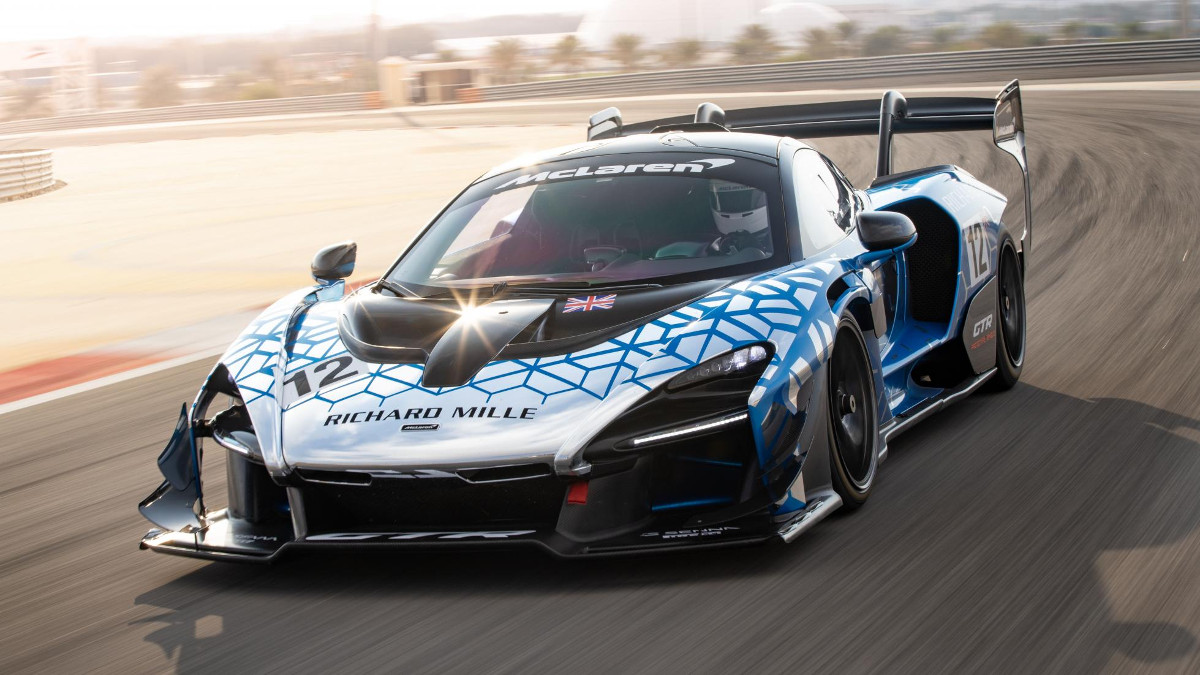
Yes, and it’s a pretty big one, because it means the Senna GTR is faster than a full-house 720S GT3 car. How much faster? An order of seconds per lap, says McLaren, although the carmaker is coy about further detail. But hey, second fastest McLaren after Carlos Sainz’s and Lando Norris’s ride is a pretty good boast.
Isn’t it? So what’s been done to turn a Senna into a GTR?
First of all, you don’t turn a Senna into this. All road-going Sennas have been built, so now it’s the turn of the 75 GTRs to have their spot on the production line. They’re being assembled at the moment at the MPC (McLaren Production Center) in Woking, and should all be built by January, at which point Speedtails will start coming down the line.
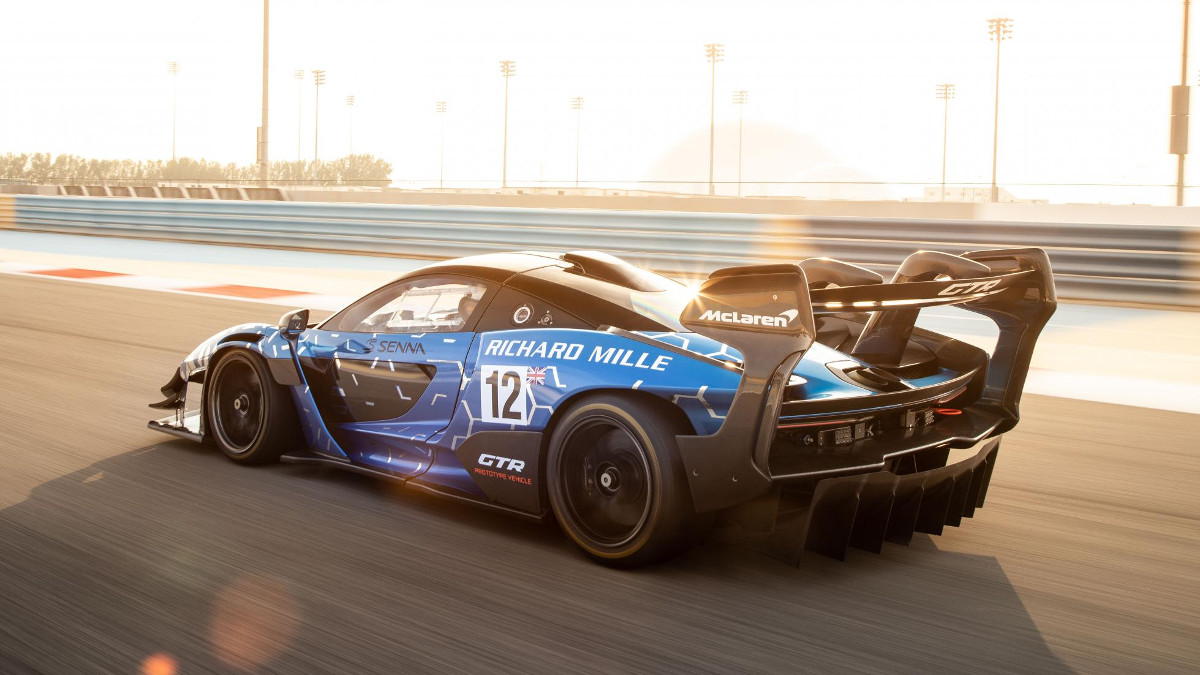
PHOTO: TopGear.com
Think of the GTR as a blend of Senna and GT3. Much of the suspension is borrowed from the GT3 racing car, and free from road homologation, an extra 25hp has been liberated from the 4.0-liter twin-turbo engine. The bodywork has sprouted, too.
More detail, please.
Engine first. Since this car is never going on road, McLaren has removed the secondary cats and fitted a more porous motorsport ‘brick’ in the primary. This reduces back pressure and up goes the power, from 800hp to 825hp. It’s all at the top end, the torque sustaining its 799Nm longer (5,500rpm-7,250rpm instead of 6,500rpm), with max power also delivered at 7,250rpm. The 8,400rpm limiter is unchanged.
CONTINUE READING BELOW ↓
The road car wasn’t pretty, but sneaking 800kg of downforce through homologation was very clever indeed. For the GTR, the wings and the aero surfaces don’t have to sit within the extremities of the car, plus you can have sharper edges and alter the car ’ s angle of attack. The 80mm of front ground clearance rises to 120mm at the rear, reducing air pressure and increasing downforce. The front splitter has been extended out several inches (the GTR is 220mm longer overall), dive planes have been added, and there are now vents above the front wheels, a prolapsed rear diffuser like Bane’s gum guard, and a rear wing of towering magnificence.
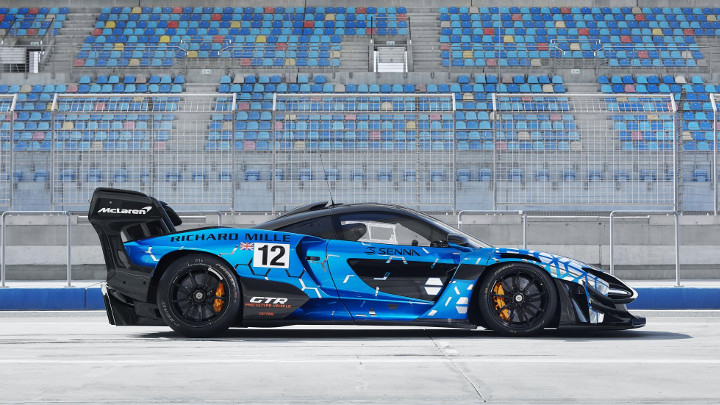
PHOTO: TopGear.com
The side supports aren’t there for structural reasons, nor are they load generating; instead, they manage the airflow down the side of the car, allowing the rear wing to work more effectively. The pylons have been tilted backwards moving the wing aft. Total downforce is over a ton at 250kph.
Suspension is double-wishbone with bespoke uprights. The arms, lighter and stiffer than the Senna’s, are from the 720S GT3, as are the Öhlins dampers—although the valving and the tuning are different. The hydraulic K damper that did heave control and height adjustability on the Senna has been dropped—no need for it. Most of the body panels are unique to the GTR. The brakes are from the standard Senna, but with different pads and brake booster.
How light is it?
Just 1,188kg dry. Which is very light indeed. But only 10kg lighter than the road car.
A bit lighter, a bit more downforce, a bit more power. Not a transformation, is it?
Quite a bit more downforce. Although that will of course actually slow you down on the straights. Don’t forget the slicks and the setup work, too. But I get your point about the baseline figures, although that’s a pretty poor way of judging the driving experience.
Tell me about that.
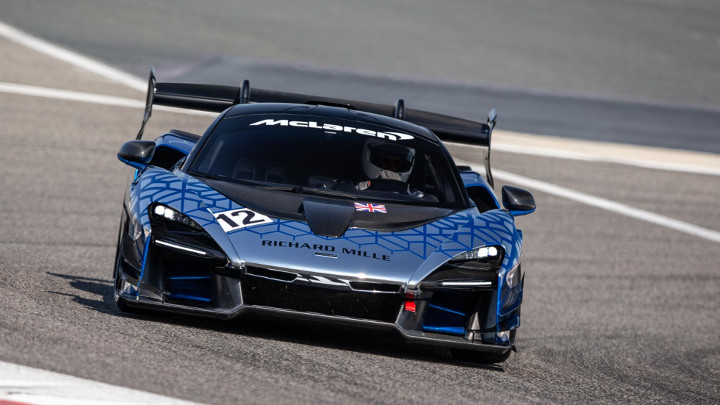
PHOTO: TopGear.com
Time to come clean. There’s a line in the literature that says “95% of the performance is achievable by 95% of drivers.” In other words, it’s as easy to extract the max from as, say, a Honda Jazz. Ish. I know it doesn’t look it, but it’s friendly. I don’t want it to be friendly, I want it to be feral. I want a car I have to master, a bit of a savage that’s going to get me sweaty-palmed with its speed and aggression. There’s every chance I’m alone in this, but I wanted you to know where I’m coming from.
Is it fast? Absolutely, although of the three speed areas (acceleration, braking, and cornering), the acceleration is by far the least impressive. At high speed, I don’t reckon it’s as fast as a 720S. Look at what it’s towing, though. The brakes are plain staggering. Nailing them at 270kph on Bahrain’s main straight, literally hitting them with everything you’ve got, straining sinews. well, it’s the one time you get to attack the car, give it a proper shoeing. After that, it’s all about accuracy and finesse. And then there’s the cornering force. The best place to feel it on the GP circuit here is Turn 12, a long, uphill fourth-gear corner, a proper summon-up-the-blood, hold-on-and-keep-turning curve.
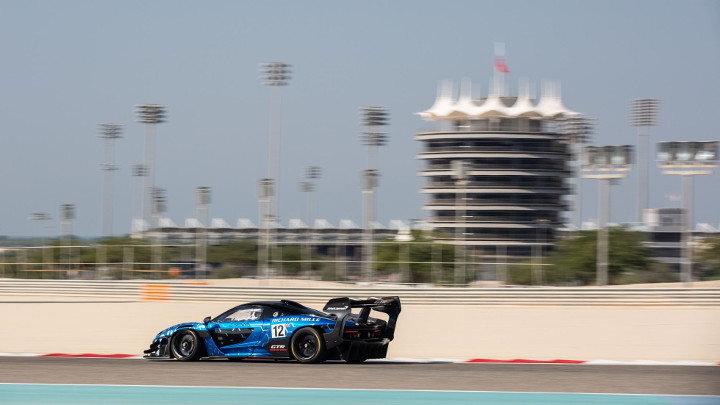
PHOTO: TopGear.com
But you can do it, you can get to the point that you feel, even beyond the limits of the slick tires and hundreds of kilos of downforce, a bit of understeer starting to emerge. Boy, are you going fast and is there a lot of force pressing on your body, though. And the only reason I’m genuinely happy pushing on? Bahrain is a Hermann Tilke circuit. Plenty of run-off.
Any moments?
One proper one, coming out of Turn 12, braking and downshifting one gear for 13, getting cocky and overconfident. Big slide, into, through, and most of the way out of Turn 13. I’m not sure I adequately apologized to Duncan Tappy, the poor racing driver tasked with coaching me around. I’m doing so now: Sorry, Duncan. But hey, at least it was catchable. Don’t think an actual racing car would have been.
A couple of times, I managed to outbrake myself, too—this in a car that’s braking from 270kph at roughly the 170-meter board before the hairpin at Turn 1. Yes, F1 cars brake at the 100 meter board, but still.
I’m sure there’s a reason you’re sharing all this.

PHOTO: TopGear.com
There is. It’s because the Senna GTR gives you so much confidence. Because it responds exactly as you want, at the moment you demand it. Because the downforce glues it harder to the track the faster you go, so it feels ultra-secure in a straight line. It’s a faithful, predictable companion. Terrifying to look at, deeply intimidating as you head out of the pits, wrenched tight into carbon buckets and gripping the little rubberized wheel. But somewhere a little over halfway around lap one, you’ve already sussed it. So you go faster. Brake later. Get scrappy. Start making mistakes.
The Senna GTR likes to be driven like a racing car, demands a certain technique—especially in the slow corners—to get the best from it. Brake all the way to the apex, gradually releasing the pressure as the aero grip fades away. Still braking a bit, you smoothly sweep the steering in, then you have to be patient. I really don’t like this part. But if you gas it at all now, you can feel the differential start to tighten back up, pushing the nose into understeer, ruining your smooth, crisp line, taking you on a trip to the outer curbs too soon. A U-shaped curve, when what’s fastest with downforce is V-shaped.
So you wait—coasting, basically—and then, when it’s nearly straight, you gun it. Go too soon, carry too much lock, or give it too much throttle, and you’ll slide a bit. And that’s slow. Thankfully, there’s traction control.
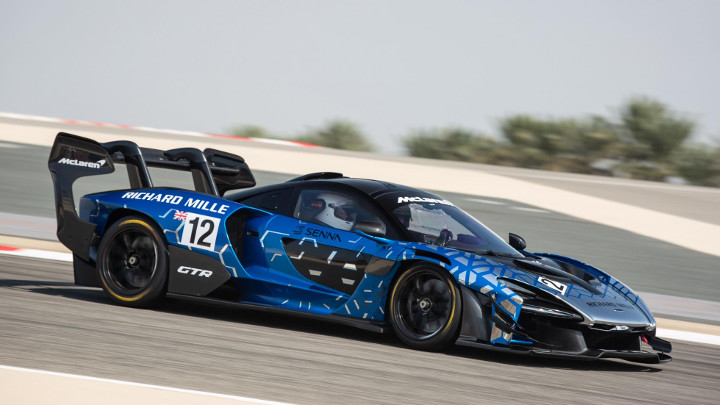
PHOTO: TopGear.com
What I’m trying to say is that driving the Senna GTR fast needs a particular technique, and has a particular reward. This is not a racing car—it’s not homologated for any race series. But for fantastically wealthy people who want a car that can give them genuine racing speeds, but don’t want to actually race, yet enjoy the analytical process of picking a circuit apart, of studying data and burrowing into setup, this is a fascinating machine. It’s a narrow demographic, a small peephole of overlap in the Venn diagram, but then there’s only 75 being built.
At about £1.3 million (around P85.8 million) each, right?
Yep. A racing car is cheaper, but it’s also more brutal, less forgiving. No straight-cut sequential gearbox here, but instead a seven-speed twin clutch. In full house Race mode, the shifts are smooth, but back it off to Track mode and there’s an ignition cut to exaggerate the shifts, fire them home a bit harder. It’s not faster, but it introduces a bit of drama. I like that.
I wish something similar was available under acceleration, too. That’s where most people feel they can get their kicks, but the Senna GTR’s DRS (which opens up the rear wing) doesn’t make enough of a difference. And although it’s massively noisy outside, inside, you’re just watching the shift lights—the engine is barely heard through helmet or over wind and tire racket. The powerband is broad and it pulls all the way to the cut-out, but the problem is that, although this sounds bonkers, 825hp just isn’t enough.

PHOTO: TopGear.com
The old P1 GTR was 1,000hp. Rougher around the edges, a bit sketchier, but bloody memorable. The Senna GTR is, as McLaren promised, much more accessible—more trustworthy, stable, and precise.
The ultimate track-attack car?
Maybe. I’ve driven several other cars like this, among them the Aston Martin Vulcan and the Brabham BT-62. One day, I’d like to find out which is fastest. For mortals, the Senna GTR is, I’m almost certain. But that’s not why I mention them. Both of those have fearsome, thunderous engines. I don’t think either is as polished as the Senna, or as trustworthy, but both feel that bit wilder, more unhinged.
What cars like this do is unpick your personality, revealing what’s beneath. Is the Senna GTR my cup of tea? Probably not. I like things a bit more blood and guts, a bit looser (more like a WRC car, if I’m being brutally honest). But I’d understand completely if the Senna GTR was the one that blew your trumpet. It’s an engineering accomplishment, that’s for sure. Delivering this much speed and inspiring such confidence is deeply impressive.
Is it significantly faster than the Senna road car?

PHOTO: TopGear.com
I suspect the numbers say it is (if McLaren would share them), but for me, the road car is the greater achievement. Getting 800kg of downforce past the legislators was an act of rare genius. Still don’t know what I’d do with one if I owned it, but what it can do on track wearing road tires is pretty nuts.
This one obviously ups the ante, but considering it’s a complete no-limits car, it’s not a massive step up. Which says more about the level the standard Senna reached, than the GTR.
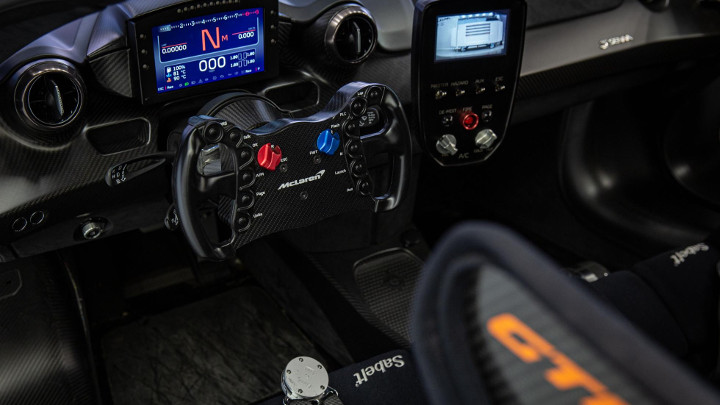
PHOTO: TopGear.com
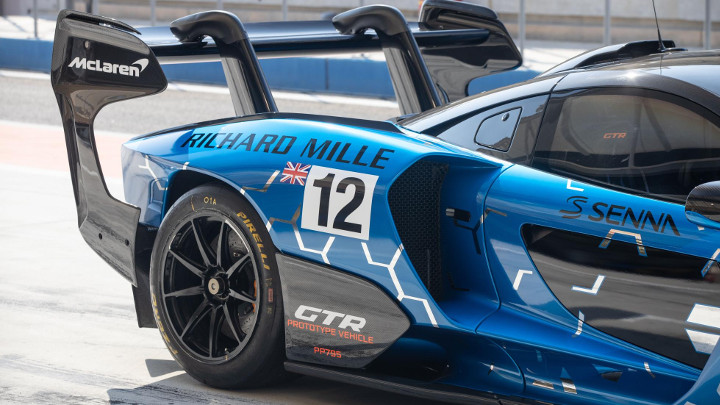
PHOTO: TopGear.com
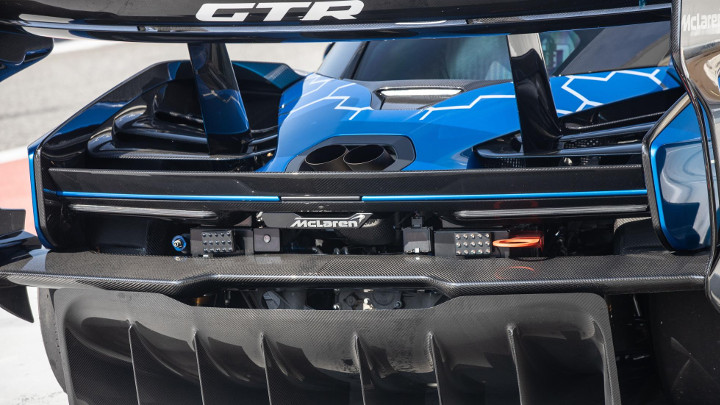
PHOTO: TopGear.com
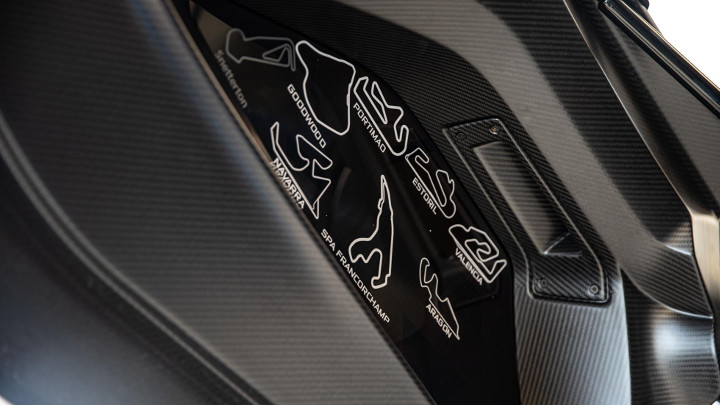
PHOTO: TopGear.com
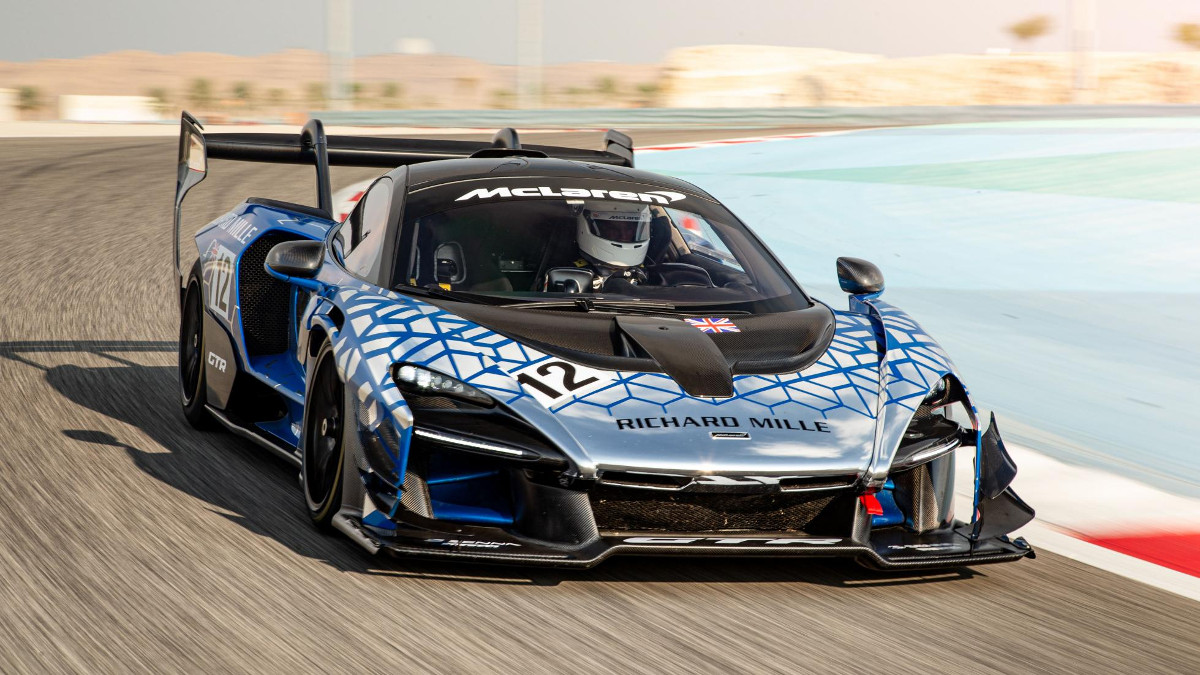
PHOTO: TopGear.com
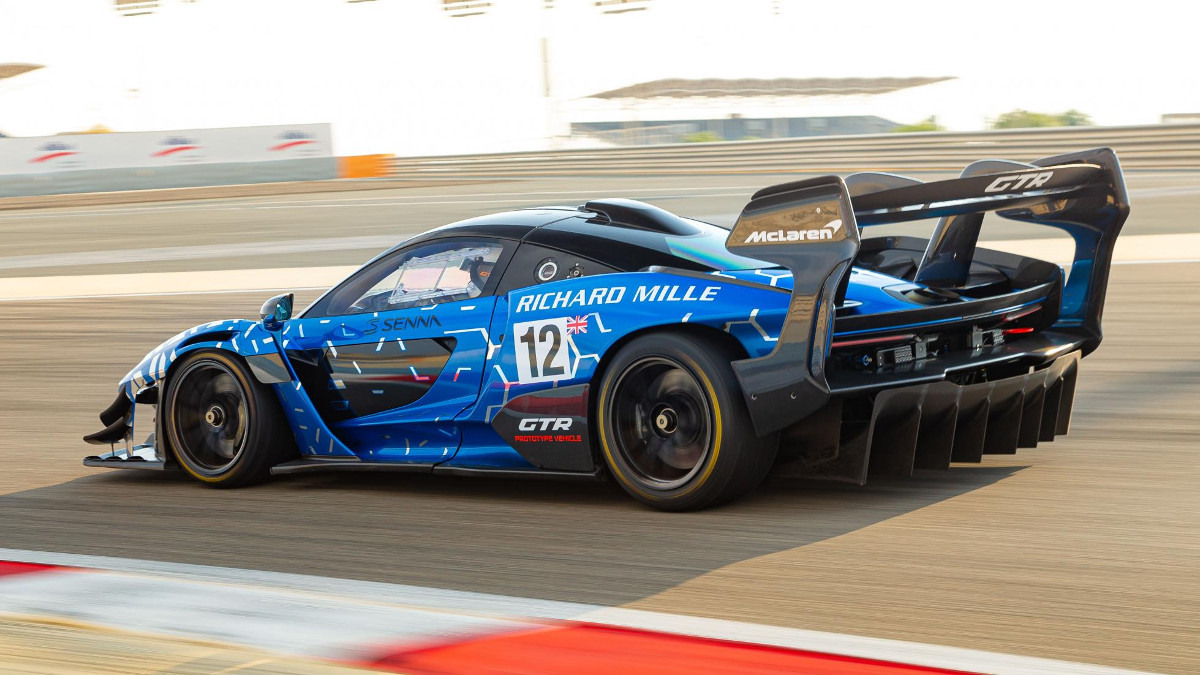
PHOTO: TopGear.com

PHOTO: TopGear.com
NOTE: This article first appeared on TopGear.com. Minor edits have been made.

